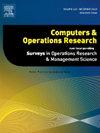用遗传算法求解i型无步进同步混合模型双面装配线平衡问题
IF 4.3
2区 工程技术
Q2 COMPUTER SCIENCE, INTERDISCIPLINARY APPLICATIONS
引用次数: 0
摘要
针对一类无步进同步混合模型双面装配线平衡问题,提出了一种遗传算法。解决这一问题的一个主要挑战是装配线具有可变输出的特点,要求求解方法生成可行的解决方案,其中某些工作站的加工时间可能超过给定的周期时间,而装配线的平均输出时间不得超过该周期时间。为了解决这个问题,提出的算法结合了一种称为预分配和正式分配的机制。它首先将任务分配给当前活动的工作站,然后评估任务分配结果是否满足给定的周期时间,并相应地进行调整。本文首先对该问题进行了建模和分析,然后介绍了所提出的遗传算法,并通过实例说明了其关键步骤。最后进行了实验研究,验证了算法的有效性。实验结果表明,该算法能够构造出符合问题特征的解。本文章由计算机程序翻译,如有差异,请以英文原文为准。
Solving Type-I unpaced synchronous mixed-model two-sided assembly line balancing problem using a genetic algorithm
This research aims to propose a genetic algorithm for the Type-I unpaced synchronous mixed-model two-sided assembly line balancing problem. A major challenge in addressing this problem is that the assembly line has the characteristic of variable output, requiring the solution approach to generate feasible solutions where the process time of certain workstations may exceed the given cycle time, while the average output time of the assembly line must not exceed this cycle time. To address this, the proposed algorithm incorporates a mechanism referred to as pre-allocation and formal allocation. It first assigns tasks to the currently active workstation, then evaluates whether the task assignment results meet the given cycle time, and adjusts them accordingly. This paper first models and analyzes the problem, then introduces the proposed genetic algorithm and illustrates its key steps through an example. Finally, experimental research is performed to demonstrate the effectiveness of the algorithm. The experimental results show that the proposed algorithm can construct solutions that match the characteristics of the problem.
求助全文
通过发布文献求助,成功后即可免费获取论文全文。
去求助
来源期刊

Computers & Operations Research
工程技术-工程:工业
CiteScore
8.60
自引率
8.70%
发文量
292
审稿时长
8.5 months
期刊介绍:
Operations research and computers meet in a large number of scientific fields, many of which are of vital current concern to our troubled society. These include, among others, ecology, transportation, safety, reliability, urban planning, economics, inventory control, investment strategy and logistics (including reverse logistics). Computers & Operations Research provides an international forum for the application of computers and operations research techniques to problems in these and related fields.
 求助内容:
求助内容: 应助结果提醒方式:
应助结果提醒方式:


